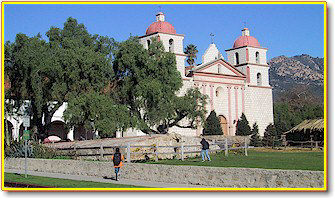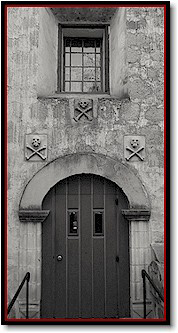 So
the public schools make a big deal out of the California missions, but
they don't really get down to the heart of what they were all
about. Most kids will come away with vague ideas (although all
ideas in fourth grade are vague) about adobe and architecture, tile
roofs, rustic kitchens, farming, saddles, and big bells. All of
this is enrobed in the spookiness of Catholicism, a mysterious, echoey,
highly patronizing authoritarian realm filled with paintings of people
either in misery or gazing powerfully upward as if they just got bonked
on the head. Throw in a little smoke, a little wine, lots of
statues and carvings of bloody crucifixion and you've got yourself one
heck of a picture of California in the nineteenth and late eighteenth
centuries.
So
the public schools make a big deal out of the California missions, but
they don't really get down to the heart of what they were all
about. Most kids will come away with vague ideas (although all
ideas in fourth grade are vague) about adobe and architecture, tile
roofs, rustic kitchens, farming, saddles, and big bells. All of
this is enrobed in the spookiness of Catholicism, a mysterious, echoey,
highly patronizing authoritarian realm filled with paintings of people
either in misery or gazing powerfully upward as if they just got bonked
on the head. Throw in a little smoke, a little wine, lots of
statues and carvings of bloody crucifixion and you've got yourself one
heck of a picture of California in the nineteenth and late eighteenth
centuries.
Not much
about the slave part.
Not a
whole lot about the land grab.
No, it was
all about baking bread and making boots, hoeing vegetables and making
candles, lots of candles.
It's a
thorny problem.
It was the
graveyard that excited the fourth graders most on the field trip
yesterday. Dozens of headstones and markers with family names
etched into marble. Grand monuments and locked-up crypts all laid
out among the native and imported flora. Oh yeah, there are also
4,000 Native Americans in the dirt there, but who knows who they
were. No markers to give their names. There was one Indian
actually mentioned by name on the tour, the first to do something there
- I forget what it was exactly, he made the first saddle or grew the
first lettuce or something - and his name was - and I want you kiddies
to write this down now, it's important - his name was
"Paisano." Yeah right. Sure. That was his
name.
Yep.
The missions. They were all about teaching the yearning Indians to
read and make candles. I think I'll go light one right now.
*****